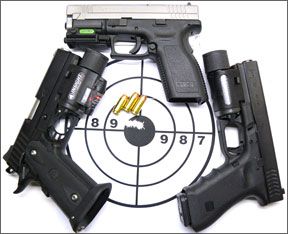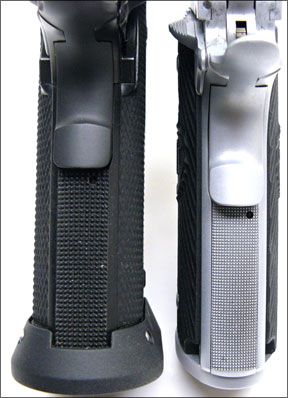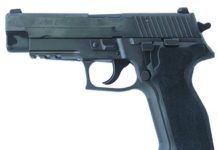The 40 S&W has become the preferred cartridge for much of the law-enforcement community because it’s more powerful than the 9mm, recoil that’s snappy but not as substantial as the 45 ACP, and magazine capacities than split the difference between the two. This month we’ll look at three guns that fit this medium-frame high-capacity format. They could aptly be classified as “tactical” pistols, because they all featured an accessory rail capable of adding a weapon light and/or laser.
Our contenders consisted of two polymer-framed guns, the Springfield XD40 ($605) and the newly introduced Glock G22 RTF2 ($599). Both guns incorporated striker-fired systems with trigger-tab designs. The third gun came from Georgetown, Texas. The STI Tactical 4.15 operates like a 1911 but utilizes a double-stack magazine to dramatically increase ammo capacity. Designated as a 2011 frame, the Tactical 4.15 is built on a patented modular platform, and incorporates a wealth of performance upgrades. All of the bells and whistles come at a price, however. Occupying the highest price point of our test guns, the Tactical 4.15 comes in at a wallet-clutching $1999 MSRP.
We conducted our testing within the friendly confines of Bass Pro Shops in Grapevine, Texas. The climate-controlled indoor pistol range was ideal shelter from the sweltering heat and one particularly nasty thunderstorm that blew up during one of our sessions. Accuracy ratings were done at 10 yards using a slow, controlled trigger press. We then progressed to multi-round firing at 8 and 15 yards. Magazine changes were made during the middle of some of our runs to see how each gun handled in a more stressful environment.
Glock G22 RTF2 40 S&W, $646
Glock’s big news at this year’s SHOT Show was the introduction of the G22 RTF2. The gun’s internal workings did not change, but its exterior had a makeover purported to improve the gun’s ergonomics. The Rough Textured Frame Version #2 (RTF2) has more than 4,000 small raised pyramids covering the front, rear, sides, and thumbrests of the frame. We trusted Glock on this point and did not attempt to count them. These “polymids” are designed to provide additional traction and an enhanced shooting grip. The G22 RTF2 has also received a redesign to its slide serrations. New crescent shapes replace the straight grooves of previous versions. Again, the new shapes are touted to improve the user’s grip and to also give the gun a new modern look.

Our evaluation of the Glock began when we open the plastic case containing our test weapon. Inside we were greeted with even more plastic. The weapon frame, two 14-round magazines, and a mag loader all were composed of Glock’s proprietary polymer. The Austrian company definitely knows how to mold plastic, as no flashing, seams, or other surface defects were evident on the gun or its accessories. The RTF2 was passed around to our testers without advising them of the Glock’s design changes. Its new textured finish didn’t jump out to us visually, but its tactile qualities were readily noted when the gun was handled. Its feel would be accurately described as gritty, and our initial consensus was that gloved operators would definitely benefit from its enhanced properties. Our lone concern was that it could be too aggressive for bare-handed shooters, but this question would soon be answered on the firing line.
The new slide serrations on the G22 weren’t initially recognized by some of our testers either. When the gun was passed around, our testers knew there was something amiss, but it took a few seconds before the fish-scale-shaped serrations were recognized. The serrations did indeed provide additional gripping area, but we’ve never had a particular problem cycling Glock slides. The consensus was that the new design didn’t hurt the gun’s functionality, and might prove beneficial on occasion.
Aside from the aforementioned updates, the G22 RTF2 resembled its older brother in fit, form, and function. We started our evaluation of the G22 by disassembling the gun to clean and lubricate it prior to firing. Slide removal from the frame was accomplished by carefully checking that the magazine was removed, verifying the chamber was empty, and dry firing the gun to release the striker. Utilizing some finger ju-jitsu, the slide was pulled back approximately 1⁄8 inch with one hand, and then two small disassembly levers were pushed down and held by the thumb and forefinger of the other hand. The slide was then pushed forward to remove it from the frame. Once the slide was separated from the frame, the guide rod and captivated single recoil spring assembly were removed, along with the barrel assembly. The elegant simplicity of this design explains why the G22 is both popular and reliable.
Once properly readied for the range, we did some mechanical and visual checks of the gun. Like all Glocks, the G22 RTF2 has no external safeties, relying on three internal ones instead. A loaded-chamber indicator appears as a lever on the outside of the slide. This indicator bulges out slightly when a round is chambered. The Glock has no striker indicator to determine if the striker is in a cocked position. The grip on the G22 RTF2 featured finger recesses and an accessory rail with a single crosscut.
Trigger pull was measured at 7.4 pounds, the heaviest of our trio. The trigger pull of the RTF2 also stood out as the least desirable of our guns during our live-fire sessions. The G22’s trigger gave a feel of compression, then a snapping release, described as “breaking a piece of peanut brittle” by one of our testers. It was not unwieldy, but was the least desirable, according to our test group. Accuracy also lagged slightly behind its competitors with all three loads tested, achieving its best accuracy with the Winchester 180-grain FMJs, a respectable 1.2-inch group at 10 yards. As we cycled from one gun to another, our testers said that the Glock required the greatest adjustment period to “settle in” for consistent groups to be fired. This is not an indictment of the gun, however. Once acclimated to the G22, rounds were fired with decent control and repeatability. Targets could be attacked aggressively, recoil was manageable, although crisp, and we experienced some muzzle flip. The rough-textured finish of the G22 did give us an enhanced grip without being so rough as to cause blisters or abrade the shooter’s hand. The gun ate everything we fed it, and magazine changes were made without much difficulty, although the right-hand-only mag release required our lefties to make adjustments. We can readily recommend upgrading to the low-profile Trijicon night sights. Their three-dot configuration presented a good sight picture, and were smooth enough not to snag when unholstering and re-holstering. The tritium inserts gave us excellent low-light capabilities as well.
Our Team Said: Overall, the Glock G22 RTF2 was a solid, reliable performer, and Glock backs its product with a limited lifetime warranty. We found the new texturing to be an upgrade from the previous finish and will benefit shooters with gloves or sweaty palms. We don’t know that the changes necessarily give the G22 RTF2 a “new modern look,” as the company attests. To us, the Glock still has Swingline stapler styling, but the gun succeeds with its utilitarian simplicity and function over cosmetics. Our test model did everything relatively well, but it lagged behind one of its competitors in each category we tested, so its ‘B’ grade reflects that.
Springfield Armory XD Service Model 4-Inch HC Bi-Tone XD9302HCSP06 40 S&W, $605
We found a lot to look over when we opened the lockable case from Springfield Armory. Our pistol came outfitted with two 12-round magazines, right-handed belt holster, dual magazine carrier, and mag loader, all made from molded plastic. Both the holster and magazine had adjustable tension screws for optimizing their fit. A bore brush and the ubiquitous gun padlock rounded out the rest of our package.
We found the matte bi-tone configuration of our test gun a refreshing look from the midnight black colors of its competitors. The Springfield logo and model number were stamped into the top and sides of the slide. Our team said it was relatively attractive—not exactly satin stainless and fine wood grips attractive, but not bad.
A striker-fired gun, the XD offered several safety indicators to advise you when the gun was ready to do business. A striker indicator in the form of a small pin was visible from the rear of the slide. A small sharkfin-like protrusion rose from the top of the slide when a round was chambered. It was prominent enough to provide both visual and tactile confirmation. This was an improvement over the more subtle Glock indicator, we thought. The XD40 also incorporated a grip safety into its design, a trait shared with our STI entry. We liked the combination of safety features, but none of them will make up for poor handling by the operator.
Disassembly of the XD40 was straightforward: The slide was locked back, and a disassembly lever was rotated and removed. Once completed, the slide can be released, and disassembly can be completed by pulling the trigger (not our favorite process), then easing the slide forward off the frame. The Springfield utilized dual-capture recoil springs, which are easily slipped out of place, allowing the tilting barrel to be rotated from the slide assembly. Once cleaning and oiling was completed, the process was repeated in reverse order, without the trigger pull.
Once put back together, the gun went through our mechanical checks. Slide movement was firm, owing in part to the double recoil springs. Trigger pull was measured at 5.6 pounds, near the middle of Springfield’s specification of 5.5 to 6.5 pounds. We noted a slight amount of stacking and creep in the XD’s double-shoe trigger before the striker released. Springfield’s striker system differs from the Glock G22 in that the striker was in a fully cocked position when the trigger was pulled. We found this assembly to be an improvement over the Glock, but in second place to the STI. A two-groove accessory rail adorned the lower end of the XD, with both front and rear cocking serrations on its slide.

The accessories supplied with our XD40 required additional scrutiny from our testers. The plastic holster is a right-hand-only affair complete with fixed belt loops. It proved to be an adequate tool, particularly because it was tension adjustable via a socket head screw and supplied wrench. The magazine carrier held two mags, and was also adjustable. Accessory rails adorned each side of the device, which allowed us to hang a gun light and the supplied mag loader for use when needed. The mag loader was a welcome relief to our thumbs when stuffing the last couple of rounds in the 12-round mags.
In fact, the magazines probably caused our biggest gripe with the XD40. The gun required a very stout thumb push to expel a full magazine. Partially or completely empty mags did drop free easily, however. Springfield does allow for southpaws, equipping the XD series with an ambidextrous magazine release.
Our shooting observations were somewhat surprising. The XD proved to be the most accurate with all three munitions used, slightly edging the STI, and turning in the only sub-1-inch group (0.9 inch) with the Winchester load. We felt that the natural pointing characteristics of the XD40 contributed to its performance. The Croatian-made gun offered a grip long enough to get all of the shooter’s fingers securely in place, along with a thumb-relief area that allowed comfortable positioning of the hand. We found the standard low-profile sights gave us a good sight picture, but would probably lean toward the available tritium option were it our carry gun.
Our Team Said: The Springfield handled our field drills in a well-behaved and consistent manner. Muzzle flip was negligible, with recoil snappy but controllable. Follow-up shots came quickly and accurately. Full magazines excepted, reloading the XD proved to be relatively simple matter. We found this Springfield model offered a very good value in a package that was dependable and relatively easy to shoot. Springfield Armory also backs its product with a limited lifetime warranty.
STI International Tactical 4.15 No. 100-41400001-00 40 S&W, $1999
STI has carved out an impressive niche among competitive shooters. The company operates an extensive machine shop, manufacturing almost all of its parts in-house. Besides marketing its own line of firearms, STI is well-known for selling parts and subassemblies that allow gun enthusiasts to put together their custom dream gun. They also stand behind their products, offering an unconditional warranty (except in cases of extreme abuse) on not only their guns, but their manufactured parts as well.
Our gun arrived in the obligatory plastic case, which also contained a small bag of spare parts, and to our disappointment a single magazine. Spares are available for $60 each. The Tactical 4.15 has an all-black finish and does initially look like a 1911. A closer inspection revealed some substantial differences, however.
Initially having the look of steel, the entire grip is actually a one-piece assembly constructed of glass-filled nylon polymer. The grip panels are part of this unitized construction and are non-removable. Front and rear checkering is molded into the grip of the Tactical 4.15 as well. An oversized aluminum mag well wraps around the base of the Tactical 4.15, and is secured with a pin passing through the gun’s mainspring housing. The STI model has a steel flattop slide with rear cocking serrations and an accessory rail with three groves cut across it. The Recoil Master guide rod is an STI design that is said to dampen felt recoil. The Tactical 4.15 also features a ramped, fully supported stainless-steel bull barrel. Sights are of the fixed low-profile variety, checkered to reduce glare. Ambidextrous thumb safeties, skeletonized curved trigger, squared and checkered trigger guard, and a high-ride beavertail grip safety round out the basic features of the pistol.
Disassembly of the Tactical 4.15 resembled the 1911. The slide was pulled back to the disassembly notch and the slide-stop lever pushed out and removed, which allows the slide to be removed from the frame. The recoil spring required a provided plastic bushing to be snapped into place before this assembly can be removed. We’re not overly fond of this design, given our penchant for losing spare parts, and definitely favored the captive springs of the Glock and Springfield. Once the due diligence of range prep was completed, we set about performing our measurement process.
The trigger pull on the Tactical 4.15 was a light and crisp 4.6 pounds. The STI came the closest to attaining the feel of a glass rod snapping when the trigger was pulled. The action was precise, smooth, and refined, attributes we would expect from a gun in its price point.
When we unboxed the STI for our range evaluation, our testers gathered around like moths to a flame. The 1911 purists were particularly keen on evaluating the potential of this high-firepower design. However, all the testers had the same reaction as they prepped for their first shot, shifting the gun in their hand in an attempt to find a comfortable grip. The large extended mag well forced a slightly off-angle unnaturally high grip to make the gun run. Additionally, the rivet anchoring the mag well in place was not seated flush, and rubbed uncomfortably against the palm of the hand. The grip was noticeably larger than on a 1911, but our testers felt it was not excessive in its girth. The Tactical 4.15 turned in accuracy numbers second to the XD, with its best average group of 1.1 inches using the Winchester 180-grain FMJs. It also produced the highest velocities with all of our test ammo, with a high mark of 1025 fps with the same Winchester loads. The STI offered up manageable recoil, but the Recoil Master guide rod did not seem to offer much dampening of the backward impulse compared to our other test guns. Muzzle flip was minimal, and the gun ran smoothly with no malfunctions.
Our Team Said: At the end of our shooting sessions, our testers offered up consistent praise and complaints of the Tactical 4.15. It was a well-tuned machine, but all the testers mentioned the mag-well fit. The uncomfortable grip angle made it the hardest gun of the three to enjoy. Shooters with small hands might find the gun more comfortable, and all of our testers agreed that we would order the gun without the mag well. The STI Tactical 4.15 was a gun that each of our testers wanted to like, but ultimately our experience with it was disappointing.





























